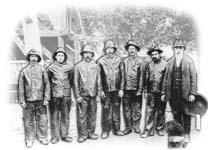



    |
|
| Immigration
It is quite apparent, that the new unskilled arrivals were attracted to employment prospects in industry, since many settled in "company" towns. However, in September 1904, the Labour Gazette reported that many miners who emigrated to Cape Breton were disappointed and moved home or westward. The chief language was Gaelic and due to their numbers in the mining towns, their culture and language fought off assimilation during the first decade of the twentieth century. Throughout the area, there was a feeling that the Gaelic language was culturally and socially inferior. This pereption, coupled with the rapid urbanization and industrialization within the towns, in addition to an English-speaking elite, led to the decline of the Gaelic language in urban and eventually rural Cape Breton. Also during this time there was a feeling among the Anglo-Saxon population of Cape Breton, that the influx of foreigners would endanger their standard of living and acts of crime and violence were not uncommon. The anglicization of foreign names was part of the assimilation process; LeFargue became LeForte, Grinevicius became Green, Porrier became Perry, etc. By the 1920s, tensions among the ethnic groups in the mining community were diminishing. Perhaps this was due to the Immigration Department's increased restrictions on the coal company's importation of labour, and also to the advent of the First World War in 1914, which slowed down the steady population and industrial growth that Cape Breton had been experiencing since the late 1800s. 
It is safe to say that the wave of immigrants were attracted to jobs, but for some foreigners, the jobs were an opportunity to escape poor conditions in their homeland. Arrivals from continental Europe and the West Indies met with cruel local conditions and had more difficulty than the Anglo-Saxons in adapting to their new home and work. The Lithuanians came in 1906 to avoid conscription and to work the mines at Sydney. The Jewish immigrants were able to escape persecution, poor conditions in Eastern Europe and the fear of conscription if they took a job in Canada. The Italians found work in the steel plant construction and later worked in Sydney Mines. Between 1906 and 1913, Polish immigrants came specifically to work in Cape Breton industry, spurred by the promise of employment. More immigrants came from the mining areas of Greece, expecting to make enough money and then return home, but most settled in Glace Bay. Another group, Blacks from Alabama, came to Sydney in 1889 to work on construction, some went to Glace Bay's Sterling areas and others to Reserve to work in the mines. The Dominion Coal Company tended to employ many people of the same ethnic group at one colliery and the people were housed, and, thus, settled together in "ethnic pockets." And as each ethnic group arrived they quickly attempted to build their own church. Religion became both the spiritual and social bond which strengthened ties between those of similar ethnic backgrounds. The Catholics were the largest single group in Glace Bay and the Presbyterians formed the second largest group in other towns. The 1920s gave rise to a variety of fraternal and benevolent associations in all the mining towns that did something to transcend class identities and at times of misfortune, members could offer assistance and consolation. Of course, societies were formed among those of certain nationalities and ethnic groups, including: Sons of the British Isles Social, Literary and Provident Society, Maple Leaf Lodge of the Society of United Fishermen and La Société de l'Assomption. In conclusion, the phenomenal growth rates of the island's population in the 1890s and early 1900s ended by the start of the First World War. But by this time the industrial way of life had taken shape and the formation of trade unions and co-operative stores made life easier for both immigrants and native Nova Scotians. |
|
The History |
The Future
Regional Impact | Mining Techniques | The Museum Main | Glossary | Site Map | Text Only |

Created by Virtual Media Productions Ltd., © 1997.
|